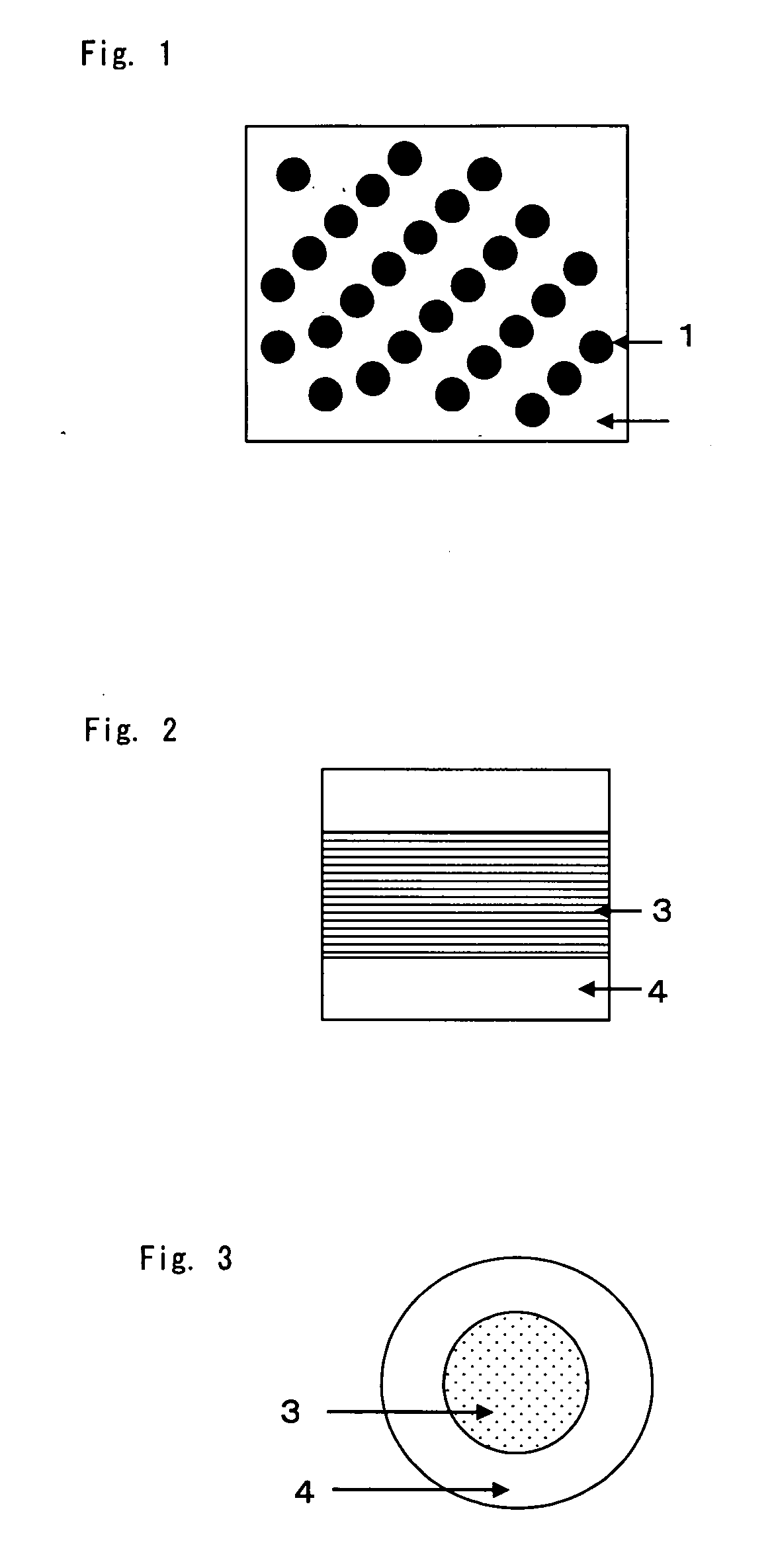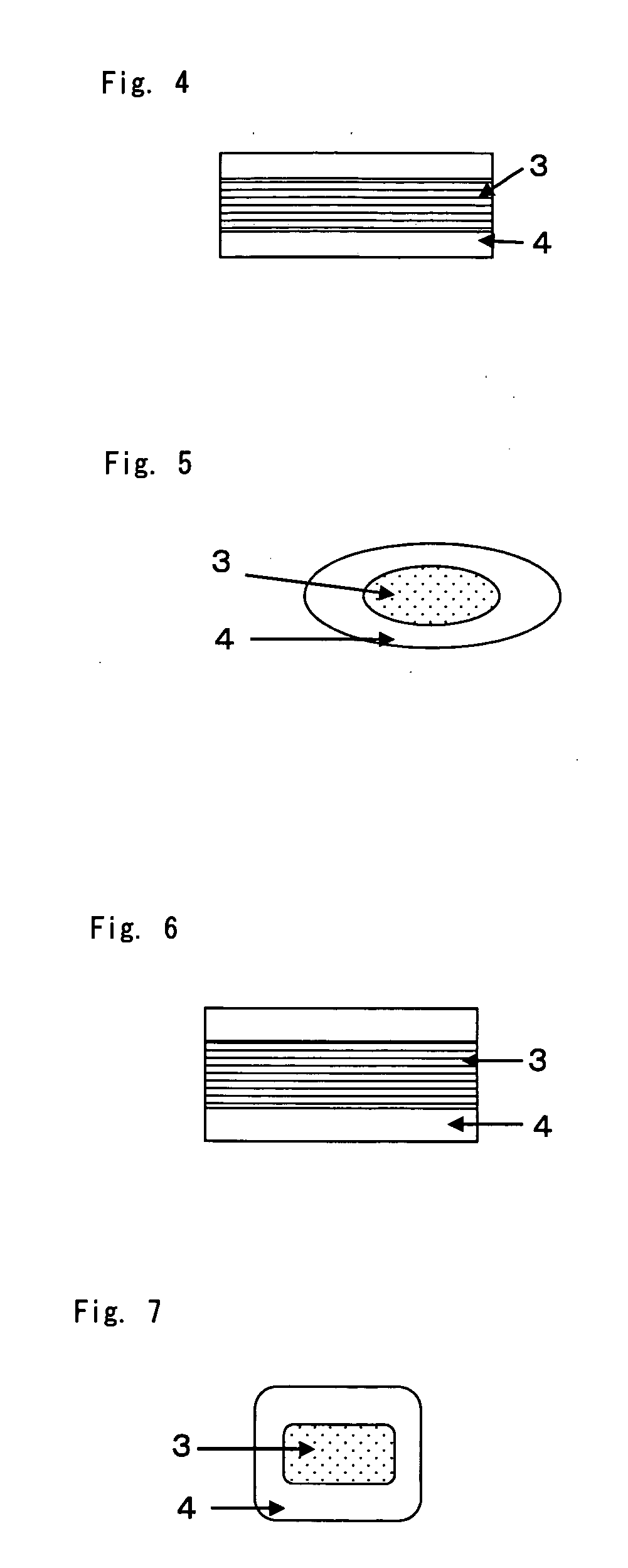Molding material and resin-adhered reinforcing fiber bundle
a technology of molding material and reinforcing fiber, which is applied in the direction of yarn, transportation and packaging, mixing, etc., can solve the problems of difficult to make a reinforcing fiber bundle impregnated with thermoplastic resin, the thermoplastic resin is not suitable for easy production of molding materials at high productivity, and the use of long fiber reinforced thermoplastic resin is not so widespread. , to achieve the effect of excellent mechanical properties, excellent adhesiveness and excellent light weigh
- Summary
- Abstract
- Description
- Claims
- Application Information
AI Technical Summary
Benefits of technology
Problems solved by technology
Method used
Image
Examples
reference example 1
[0144]A copolymer with polyacrylonitrile as the main component was spun, and subsequently the fibers were treated by burning and treated by oxidation on the surfaces, to obtain 24,000 continuous carbon fibers as single fibers. The continuous carbon fibers had the following properties.
Mass per unit length: 1.6 g / m
Specific gravity: 1.8
Surface oxygen concentration ratio [O / C]: 0.06
Tensile strength: 4,600 MPa.
Tensile modulus of elasticity: 220 GPa.
[0145]Among the above items, the surface oxygen concentration ratio was obtained using the carbon fibers treated by oxidation on the surfaces thereof according to the following procedure by X-ray photoelectron spectroscopy. At first, the carbon fiber bundle was cut at 20 mm, and spread on a sample support base made of copper, and using AlKα1,2 as the X-ray source, the sample chamber was internally kept at 1×108 Torr. As the correction value of the peak for the electrification at the time of measurement, t...
reference example 2
[0146]A copolymer with polyacrylonitrile as the main component was spun, and subsequently the fibers were treated by burning and treated by oxidation on the surfaces, to obtain 24,000 continuous carbon fibers as single fibers. The continuous carbon fibers had the following properties.
Single fiber diameter: 7 μm
Mass per unit weight: 1.6 g / m
Specific gravity: 1.8
Surface oxygen concentration ratio [O / C]: 0.12
Tensile strength: 4,600 MPa
Tensile modulus of elasticity: 220 GPa
reference example 3
Preparation of Propylene-Based Resin Mixture PP (1)
[0147]Ninety one parts by weight of propylene-butene-ethylene copolymer (b-1) (building blocks derived from propylene (hereinafter referred to also as “C3”)=66 mol %, Mw=90,000) as the first propylene-based resin (B), 9 parts by weight of maleic anhydride-modified propylene-ethylene copolymer (C3=98 mol %, Mw=25,000, acid content=0.81 millimole equivalent) as a precursor of the second propylene-based resin (C) and 3 parts by weight of potassium oleate as a surfactant were mixed. The mixture was supplied into the hopper of a twin-screw extruder (PCM-30 produced by Ikegai Tekko K.K., L / D=40) at a rate of 3,000 g / hour, and 20% potassium hydroxide aqueous solution was continuously supplied into the supply port provided at the vent of the extruder at a rate of 90 g / hour, while the resin mixture was continuously extruded at a heating temperature of 210° C. The extruded resin mixture was cooled to 110° C. by a jacketed static mixer install...
PUM
| Property | Measurement | Unit |
|---|---|---|
| wt % | aaaaa | aaaaa |
| wt % | aaaaa | aaaaa |
| acid value | aaaaa | aaaaa |
Abstract
Description
Claims
Application Information
 Login to View More
Login to View More - R&D
- Intellectual Property
- Life Sciences
- Materials
- Tech Scout
- Unparalleled Data Quality
- Higher Quality Content
- 60% Fewer Hallucinations
Browse by: Latest US Patents, China's latest patents, Technical Efficacy Thesaurus, Application Domain, Technology Topic, Popular Technical Reports.
© 2025 PatSnap. All rights reserved.Legal|Privacy policy|Modern Slavery Act Transparency Statement|Sitemap|About US| Contact US: help@patsnap.com



